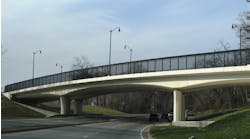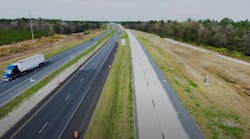Quiet, safe travel has always been the goal of both motorists and transportation agencies alike.
Often referred to as “environmental noise,” the busy highway din has become an issue in many parts of the world, including the U.S. In the past this was a dilemma, since the more aggressive surfaces that provided the best friction and safe driving usually were the noisier surfaces. A quieter surface often meant that the pavement’s surface texture had worn down from long-term use. Through extensive research and testing, an innovative grinding technique for concrete surfaces—the Next Generation Concrete Surface (NGCS)—now exists for quieter travel and increased friction. The NGCS is a long-lasting, economical, noise-reducing surface developed for concrete pavement. It is a diamond saw-cut surface designed to provide a consistent profile absent of positive or upward texture, resulting in a uniform land-profile design with a predominantly negative texture. Conventional diamond-ground surfaces produce a positive or upward texture. Since the NGCS is a “manufactured” surface, it is more consistent and predictable than most traditional pavement surfaces.
NGCS is a hybrid texture that resembles a combination of diamond grinding and longitudinal grooving. The texture can be constructed as either a single-pass or two-pass operation using diamond-tipped saw blades mounted on conventional diamond grinding and grooving equipment. These textures can be used for both new construction and rehabilitation of existing surfaces. “The response to the quieter ride has been overwhelming,” said John Roberts, executive director of the International Grooving and Grinding Association (IGGA). “Residents have called in asking how the roads became so quiet, and it has even made the front page in the local newspapers.” The newly quiet highway I-35 recently made front-page news of the local newspaper, lauding the success of the new concrete surface treatment. Even local businesses were commenting on the decreased sound level.
Justin Steinbach, the general manager of the Edgewater Resort and Waterpark, noted in the Duluth News Tribune many of the same sentiments about the quieter highway.
“Absolutely, we can tell the difference,” he remarked in the Duluth News Tribune article, “Quieter commute on new interstate.” “It’s fantastic that [Mn/DOT was] able to take a look into the issue . . . Since they reopened the freeway back around Labor Day we haven’t fielded one complaint.” The first large-scale use of this innovative grinding technique is on a high-traffic thoroughfare in Minnesota. This innovative grinding is being completed on two segments of the I-35 Duluth Mega Project: I-35 northbound and southbound from approximately Boundary Avenue (CSAH 14) to Central Avenue and I-35 northbound and southbound from 21st Avenue East to 26th Avenue East. The repaired sections are equal to 3.7 miles of a four-lane freeway. Both segments are located within an ongoing concrete pavement rehabilitation (CPR) project.
They all saw it
In September, the Minnesota Department of Transportation (Mn/DOT), the Concrete Paving Association of Minnesota (CPAM) and the IGGA hosted a live demonstration of NGCS construction and a tour of the I-35 project site in Duluth, followed by a field demonstration of the On Board Sound Intensity (OBSI) tire-pavement noise-testing apparatus.
Contractors, suppliers, agencies and even a top representative from the Federal Highway Administration gathered in Duluth to see what NGCS was all about. Most had heard about it before, but wanted to come out and actually see it.
“I think everybody really liked what they saw,” said Matt Zeller, executive director for CPAM. At the event, representatives of Mn/DOT explained the construction process and their purpose in using the NGCS on this section of roadway.
Pat Huston, Mn/DOT District 1 resident construction engineer, explained that there were three primary reasons that NGCS was selected for this project: to supply enhanced friction/skid resistance; to enhance the pavement ride; and to reduce noise. NGCS meets all those requirements.
The demonstration attracted many saw-blade and equipment manufacturers—all interested in learning how to better construct the NGCS while minimizing costs. “Everyone at the demo was excited to hear about the results and see the actual surface constructed on the highway,” said Zeller.
The audience at the demonstration shared the same enthusiasm as the local residents and businesses.
“Rarely does a road surface gain such attention. The interest this event received illustrates the need for this technique,” said Jake Steinberg of Construction Materials Inc.
Zeller feels it will take several large-scale projects before competitive forces set a baseline and actual costs can be determined. At best guess, it appears costs are running 25% higher than conventional grinding. But, he stressed, in exchange the residents and business owners living adjacent to the roadway are experiencing a better quality of life.
The event also included a demonstration of the OBSI. OBSI is a system used to measure noise created by tire-pavement interaction. It measures the noise caused by the tire-pavement interaction using a set of sophisticated microphones mounted on the rear wheel near the tire-pavement interface. Tire-pavement noise is a dominant traffic noise source on a highway. Passenger cars actually generate 70% to 90% of their total noise through the tire-pavement interaction.
For the segment of I-35 from 21st Avenue East to 26th Avenue East, Mn/DOT was interested in the added benefit of tire-pavement noise reduction in addition to the primary goals of a smooth ride and increased friction. “At the newest portion of I-35, right where it ends, are several hotels, and they were voicing concerns about the noise. Mn/DOT was currently doing rehab on the road, so we decided to try this noise-reducing technique. NGCS was chosen because we were looking for a grinding pattern that was quieter,” said Huston.
Drumming along
The NGCS surface was developed through a partnership consisting of the IGGA, the American Concrete Pavement Association (ACPA), the Portland Cement Association (PCA) and Purdue University. Recognizing the need for quieter pavements, the groups worked together to evaluate and develop a quieter concrete-pavement surface.
Purdue University’s Herrick Laboratories of West Lafayette, Ind., conducted research using its Tire Pavement Test Apparatus (TPTA), which can test nearly any pavement texture. It evaluates texture designs unconstrained by current construction capabilities or costs associated with field-test-section construction and evaluation and without the resulting traffic control or safety issues. The TPTA is a 38,000-lb, 12-ft-diam. drum that allows the testing of multiple pavement textures and compositions with a range of tire designs. The machine takes six curved textures of pavement to form a circle around the vertical edge of the drum. Then two tires, mounted on opposite ends of a beam, are rolled over the test samples while sensors and microphones record the data.
The Purdue work evaluated the variables affecting the construction of diamond-ground textures and the joint-slap effect associated with transverse-joint noise generation. Test findings indicated that the geometric configuration of the blades and spacers used to construct diamond-ground textures was not the controlling factor in noise generation, but rather, the resulting fin profile was the most important factor. Producing a low-noise diamond-ground surface required creating uniform and consistent land profiles.
To verify this finding NGCS was created that consisted of a uniform land profile design with essentially an all-negative texture. This surface texture produced the lowest tire-pavement noise levels in the study. The surface was then constructed in the field, using actual diamond-grinding equipment to confirm the laboratory study.
Three-year education
Following the Purdue research, extensive field testing and evaluation were conducted by Mn/DOT at the MnROAD pavement-research facility. Although this surface texture has been constructed at a number of locations across North America, the Duluth location marks the first time NGCS has been employed on an urban interstate concrete pavement.
“The NGCS has undergone three full years of research at our MnROAD facility, and each stage has delivered a noticeable improvement in quietness, friction and durability. It has been tested in low-volume traffic (MnROAD Low Volume Loop) and high-volume traffic (MnROAD Mainline) where a total of four cells have an innovative grinding configuration,” said Bernard Izevbekhai, research operations engineer for Mn/DOT.
Back in 2007, MnROAD started testing the NGCS on select pavements. The first test was placed in two phases, the second section was placed in one phase. In the test sections it was found that the NGCS was at least 3 decibels (dB) quieter than the traditional surface and 5 dB quieter than the transverse tining.
“Many things had to be addressed, one of them was quietness,” said Izevbekhai. With these results, MnROAD knew they had developed the quietest concrete surface around.
At first there was some resistance from environmental agencies. They were not sure how MnROAD was measuring the quietness. To answer the environmental concerns, the first project ground was a section of I-94 near St Cloud, Minn., in 2009.
“We measured the quietness using the environmental agencies’ methods as well as MnROAD’s test methods. The results were that the NGCS was quieter by the environmental standards, as well as MnROAD’s standards. Additionally, we receive numerous calls from motorists who noticed how quiet the pavement was,” said Izevbekhai.
Shouting success
The NGCS sound levels measure at 96.8 dB, the quietest concrete surface ever measured. “We can easily say it is the quietest surface today,” said Izevbekhai.
“Our research shows that by performing this innovative grind on a pavement that was formerly transversely tined, there is a 6-dB reduction when measured using the On Board Sound Intensity method. In the decibel scale, 6 dB is equivalent to 75% reduction in the tire-pavement sound source. Typically, when a conventional grind is performed on a surface that was formerly conventionally ground, there is usually a 3- to 4-dB reduction. This is equivalent to a range of 50 to 67% reduction in the intensity of the tire-pavement source,” said Izevbekhai.
To understand the difference in the sound level with NGCS, a high-traffic freeway with 240 vehicles will now sound comparable to only 120 vehicles of traffic, a substantial reduction in sound. This is a substantial reduction for areas with a need for quieter roads, such as urban or residential areas. Through the research and extensive testing, the knowledge base has increased about this technique, and the environmental agencies are acknowledging the results of using this innovative grinding technique.
Those involved with the NGCS feel it is a real winner. Even when the construction crews are working on the roads, they notice that the noise levels are now substantially lower from the passing traffic on the roads completed with NGCS. The positive feedback from the community confirms that the noise reduction is being noticed.
Spreading forward
All mainline work on the Duluth project will end in 2011, and the remainder ramp work will conclude in 2012.
“We look forward to seeing the NGCS implemented where needed throughout the country,” said Roberts. “The initial reaction has been so favorable that we believe as the word spreads about this technique, demand for it in noise-sensitive areas will quickly rise. Municipalities are always looking for new ways to improve the quality of life for their residents, and this provides one of the basics—a quieter community.”
The outlook for the NGCS is safer, quieter roads built in concrete, not asphalt. The NGCS can be considered whenever a high-speed roadway will be ground for ride or friction reasons. The impact on the industry will be a road treatment that drivers, the surrounding community and DOTs will notice and appreciate due to the safety, quietness and better ride.


